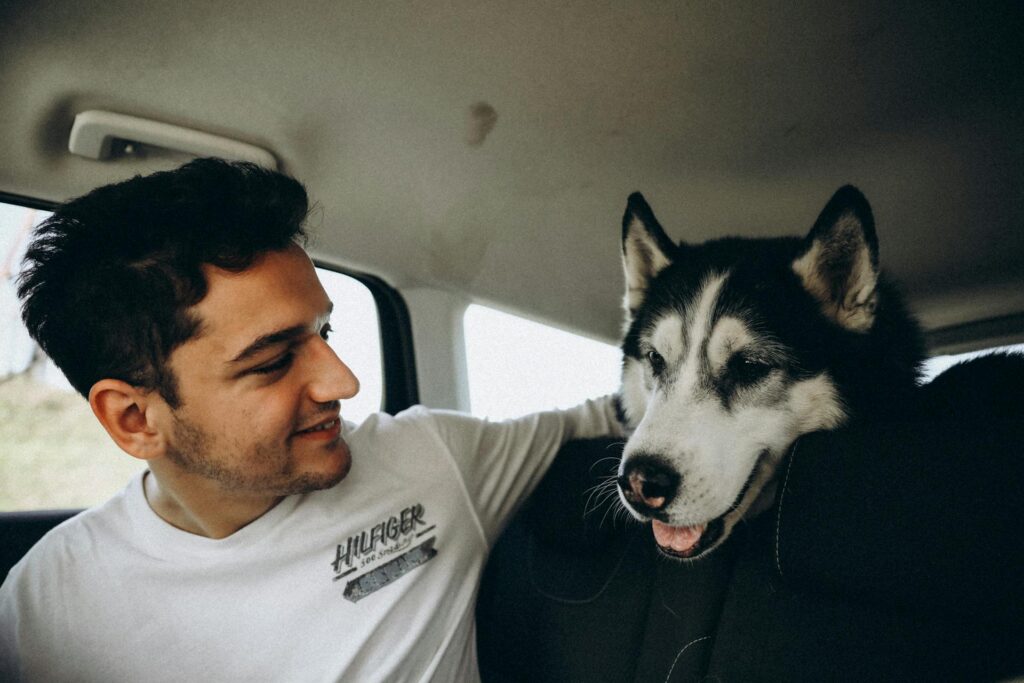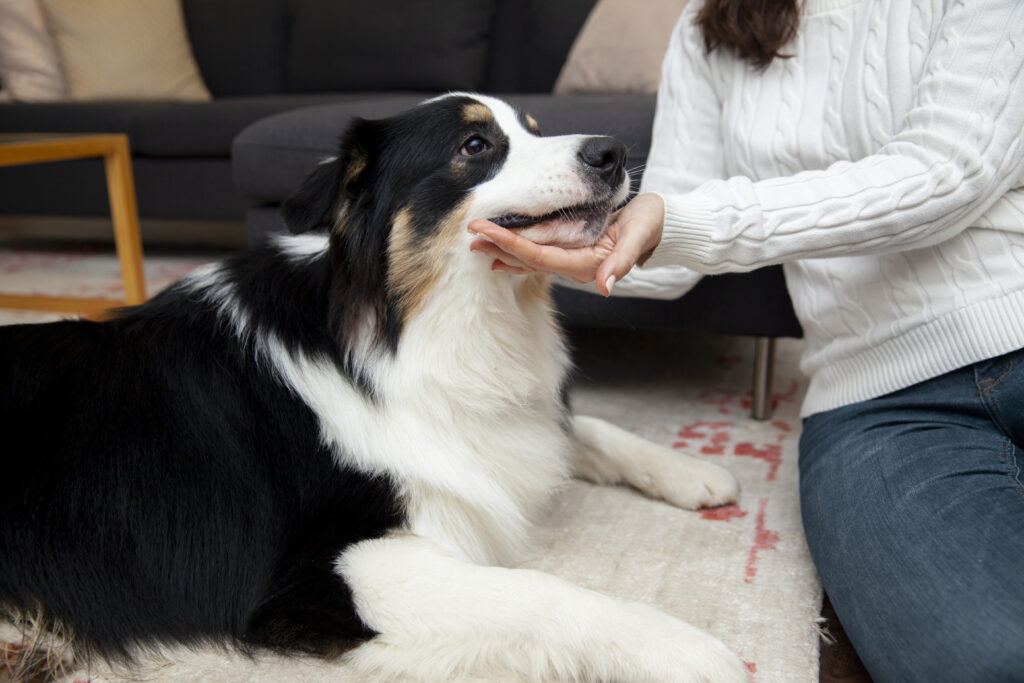
Have you ever looked into your dog’s eyes and wondered what they’re thinking? Do those tail wags and playful barks really mean something, or are they just random actions? Well, the answer is both yes and no! Dogs don’t have a language in the same way humans do, but they definitely have ways of communicating with us and each other.
This article will be your guide to deciphering: Do Dogs Have Their Own Language. We’ll explore how dogs use body language, vocalizations, and even scent to “talk” to each other and their human companions. By understanding these communication methods, you can build a stronger bond with your furry friend and become the ultimate doggy translator!
Here are some key questions we’ll answer:
- Can dogs really talk? (Spoiler alert: not like us!)
- How do dogs communicate with each other?
- How do dogs communicate with humans?
- How can I understand what my dog is trying to tell me?
- Can I “talk” to my dog in their language?
So, grab your favorite chew toy, cuddle up with your pup, and let’s dive in!
Beyond Woofs and Barks: Unveiling the Different Ways Dogs Communicate
While dogs don’t have a spoken language with complex grammar and vocabulary, they have a rich and nuanced way of communicating that involves a combination of:

- Body Language: This is the most important way dogs communicate. From tail wags and ear positions to posture and facial expressions, every twitch and turn tells a story.
- Vocalizations: Yes, barks, whines, growls, and even yips all have meaning! The pitch, volume, and duration of these vocalizations can tell you a lot about your dog’s mood and intentions.
- Scent: Dogs have an incredible sense of smell, and they use scent to communicate in ways we can’t even imagine. They can detect emotions, identify other dogs, and even leave messages for each other through scent marking.
Also Read: Post-Grooming Behavior: Why Does My Dog Keep Sitting After Grooming?
Doggy Sign Language: Decoding Body Language
Understanding your dog’s body language is key to unlocking the secrets of their communication. Here are some common body language cues and their meanings:
- Tail wags: A happy, relaxed dog will wag their tail loosely. A high, stiff wag might indicate excitement or alertness, while a tucked tail can signal fear or submission.

- Ears: Perked-up ears show attentiveness and interest, while flattened ears can indicate fear, submission, or aggression.
- Eyes: Soft, relaxed eyes are a good sign. Direct eye contact can be a sign of dominance or challenge, while averted eyes can show shyness or submission.
- Posture: A relaxed, upright posture indicates confidence. A crouching posture can signal fear, while a stiff-legged stance might suggest dominance or aggression.
- Facial expressions: Dogs can frown, smile, and even raise their eyebrows! Pay attention to the wrinkles around their eyes and the shape of their mouth to understand their emotions.
Woof Woof! Decoding Dog Sounds
While not as complex as human language, dog vocalizations definitely convey meaning. Here’s a quick guide to some common doggy sounds:
- Barks: Barks can have many different meanings, depending on the pitch, volume, and duration. A single sharp bark could be an alert, while a series of rapid barks might indicate excitement or playfulness.
- Whines: Whines are often used to express needs or desires, such as wanting food, attention, or to go outside.
- Growls: Growls are a warning sign that a dog feels threatened or uncomfortable. It’s important to take growls seriously and remove your dog from the situation if necessary.

- Yips: Yips can express excitement, surprise, or pain. The context will help you determine the meaning.
- Pants: Panting can be a sign of exertion, heat, or stress.
Also Read: Understanding The Reasons: Why Is My Dog Panting So Much? A Comprehensive Guide
Smelly Messages: The Power of Scent in Dog Communication
Dogs have an amazing sense of smell that allows them to communicate in ways we can’t perceive. Here’s how scent plays a role in their world:
- Scent marking: Dogs use urine and anal gland secretions to mark their territory and leave messages for other dogs. These scent messages can tell other dogs about the sex, age, and even mood of the dog who left them.
- Identifying others: Dogs can learn to recognize other dogs by their unique scent. This helps them to identify friends, family, and potential threats.
- Emotions: Studies suggest that dogs may be able to detect human emotions through scent. This could explain why your dog might come to comfort you when you’re feeling sad.
Building Bridges: How Humans Can Understand Their Dogs
Understanding dog communication is a two-way street! Here are some tips to help you decipher your dog’s messages:
- Pay attention to context: Consider the situation when interpreting your dog’s signals. A wagging tail in the park likely means excitement for playtime, while a wagging tail at the vet might indicate nervousness.
- Look for clusters of cues: Don’t rely on one signal alone. Dogs communicate through a combination of body language, vocalizations, and scent. Look for the whole picture to understand the message.
- Learn about dog breeds: Some breeds have unique communication styles. For example, Huskies are known for their vocalizations, while Basset Hounds might rely more on scent marking.
- Educate yourself: There are many resources available to help you learn about dog communication. Books, websites, and even dog training classes can be a wealth of information.
Speaking Dog: Can We Talk Back to Our Furry Friends?
While we can’t speak fluent “dog” there are ways to communicate with your dog in a way they understand. Here are some tips:
- Use body language: Mirror your dog’s body language to show them you understand and feel comfortable. A relaxed posture, gentle petting, and playful ear scratches can all send positive messages.
- Mind your tone of voice: Dogs are sensitive to the tone of our voice. Speak in a calm, soothing voice when interacting with your dog, even if you’re giving them a command.
- Keep it consistent: Use consistent words and cues for commands. This will help your dog learn what you expect from them.
- Reward good behavior: Positive reinforcement is key to effective communication with your dog. Praise, treats, and affection can encourage your dog to repeat the desired behaviors.
Building a Lasting Bond: The Importance of Communication
By understanding how dogs communicate and learning to “speak dog” yourself, you can build a stronger and more meaningful bond with your furry companion. The more you understand your dog’s needs and wants, the better you can care for them and provide them with a happy and fulfilling life.
Remember, communication is a two-way street. The more you pay attention to your dog’s signals, the easier it will be for them to communicate with you. So, put on your detective hat, grab some treats, and get ready to unlock the fascinating world of dog communication!
Resources for the Aspiring Dog Whisperer
Here are some resources that you might find helpful on your journey to becoming a doggy translator:
- The American Kennel Club (AKC): https://www.akc.org/ The AKC website has a wealth of information on dog behavior and communication.
- The American Society for the Prevention of Cruelty to Animals (ASPCA): https://www.aspca.org/ The ASPCA website has articles and resources on understanding dog body language.
- The Association of Professional Dog Trainers (APDT): https://apdt.com/ The APDT website can help you find a certified professional dog trainer who can teach you more about dog communication.
With a little patience, practice, and the information in this article, you’ll be well on your way to understanding your dog’s unique language and building a strong, communicative relationship. Happy tail wags and happy training!
How Can I Understand my Dog’s Language?
Here are some specific ways you can put the information from this article into action and start understanding your dog’s language:
Become a Body Language Detective:
- Observe: Spend some quality time just watching your dog interact with the world around them. Notice their posture, tail wags, ear positions, facial expressions, and how they use their eyes.
- Context is Key: Don’t interpret signals in isolation. Consider the situation when trying to decipher your dog’s message. For example, a low growl at the vet might mean fear, while a low growl during playtime might be a playful warning.
- Cluster Power: Look for combinations of cues. A wagging tail with a relaxed posture and happy eyes likely indicates excitement, while a tucked tail with flattened ears and whimpers suggests fear.

Become a Dog Whisperer (Even if it’s just a whisper):
- Mirror, Mirror: Mimic your dog’s positive body language to show you understand and feel safe. A relaxed posture, gentle petting, and playful ear scratches can all send positive messages.
- Speak Softly and Sweetly: Use a calm and soothing tone of voice when interacting with your dog. Avoid yelling or using harsh tones, even if you’re giving a command.
- Be Consistent: Use the same words and cues consistently for commands like “sit,” “stay,” or “go potty.” This helps your dog learn what you expect from them.
- Reward the Good Stuff: Positive reinforcement is key! When your dog exhibits a desired behavior, praise them with words, treats, or petting to encourage them to repeat it.
Become a Dog Learning Machine:
- Read Up: There are many resources available to help you learn more about dog communication. The resources listed at the end of the article (http://images.akc.org/pdf/ebook/Canine_Body_Language.pdf, https://www.aspcapro.org/sites/default/files/canine-body-language-aspca.pdf) are a great place to start.
- Enroll in Dog School (Optional): Consider taking a dog training class together! This can be a fun way to learn more about dog communication and build a stronger bond with your pup in a positive and structured environment.
Remember, understanding your dog’s language takes time, patience, and practice. The more you observe, interact, and learn, the better you’ll be able to decode your furry friend’s unique way of communicating.
Do Dogs Have Their Own Language? FAQs
While dogs don’t have a spoken language with complex grammar and vocabulary like humans do, they have a rich and nuanced way of communicating with each other and with us. Here are some frequently asked questions to delve deeper into how dogs “speak”:
- Can dogs understand human language?
Dogs can understand some words and phrases, especially those associated with their daily routines (walk, food, play) or commands they’ve been trained on (sit, stay, come). However, they primarily rely on body language, tone of voice, and context to understand what we’re trying to communicate.
- Do all dog breeds communicate the same way?
There are some general similarities in dog communication across breeds. However, some breeds might have unique quirks. For example, Huskies are known for their vocalizations (talking Huskies!), while Basset Hounds might rely more on scent marking.
- How can I tell if my dog is happy?
A relaxed posture with a wagging tail, soft eyes, and playful energy are all good signs your dog is happy. They might also lick your face, nudge your hand for attention, or excitedly circle around you.
- How can I tell if my dog is scared?
Signs of fear in dogs include tucked tail, flattened ears, whimpering, and averted eyes. They might also try to hide behind you or cower when faced with something scary.
- What should I do if my dog is growling?
A growl is a warning sign that your dog feels threatened or uncomfortable. It’s important to take growls seriously. Remove your dog from the situation if possible and consult a trainer if the growling is frequent or seems aggressive.
- Is it okay to yell at my dog if they’re misbehaving?
Yelling or using harsh tones can actually make your dog more anxious or fearful. Positive reinforcement with treats, praise, and affection is a much more effective way to train your dog and communicate your expectations.
- Can dogs understand human emotions?
Studies suggest that dogs may be able to pick up on our emotions through a combination of scent, tone of voice, and facial expressions. This might explain why your dog might come to comfort you when you’re feeling sad.
- How can I teach my dog new tricks?
The key to teaching your dog new tricks is positive reinforcement. Use short, clear commands, plenty of praise and treats, and be patient. Keep training sessions short and fun for your dog.
- Should I get a professional dog trainer?
A professional dog trainer can be a valuable resource, especially if you’re having trouble understanding your dog’s behavior or teaching them new commands. They can provide personalized guidance and help you build a stronger bond with your furry friend.
- Where can I learn more about dog communication?
There are many resources available online and in libraries about dog behavior and communication. The American Kennel Club (AKC) http://images.akc.org/pdf/ebook/Canine_Body_Language.pdf and the American Society for the Prevention of Cruelty to Animals (ASPCA) https://www.aspcapro.org/sites/default/files/canine-body-language-aspca.pdf both have helpful resources on their websites.

